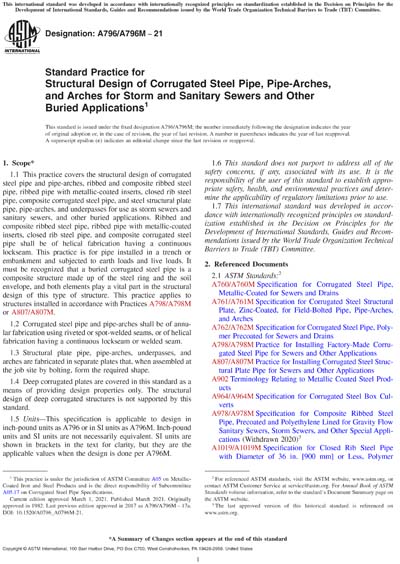Most recent
ASTM A796/A796M-21
Standard Practice for Structural Design of Corrugated Steel Pipe, Pipe-Arches, and Arches for Storm and Sanitary Sewers and Other Buried Applications
1.1 This practice covers the structural design of corrugated steel pipe and pipe-arches, ribbed and composite ribbed steel pipe, ribbed pipe with metallic-coated inserts, closed rib steel pipe, composite corrugated steel pipe, and steel structural plate pipe, pipe-arches, and underpasses for use as storm sewers and sanitary sewers, and other buried applications. Ribbed and composite ribbed steel pipe, ribbed pipe with metallic-coated inserts, closed rib steel pipe, and composite corrugated steel pipe shall be of helical fabrication having a continuous lockseam. This practice is for pipe installed in a trench or embankment and subjected to earth loads and live loads. It must be recognized that a buried corrugated steel pipe is a composite structure made up of the steel ring and the soil envelope, and both elements play a vital part in the structural design of this type of structure. This practice applies to structures installed in accordance with Practices A798/A798M or A807/A807M.
1.2 Corrugated steel pipe and pipe-arches shall be of annular fabrication using riveted or spot-welded seams, or of helical fabrication having a continuous lockseam or welded seam.
1.3 Structural plate pipe, pipe-arches, underpasses, and arches are fabricated in separate plates that, when assembled at the job site by bolting, form the required shape.
1.4 Deep corrugated plates are covered in this standard as a means of providing design properties only. The structural design of deep corrugated structures is not supported by this standard.
1.5 Units—This specification is applicable to design in inch-pound units as A796 or in SI units as A796M. Inch-pound units and SI units are not necessarily equivalent. SI units are shown in brackets in the text for clarity, but they are the applicable values when the design is done per A796M.
1.6 This standard does not purport to address all of the safety concerns, if any, associated with its use. It is the responsibility of the user of this standard to establish appropriate safety, health, and environmental practices and determine the applicability of regulatory limitations prior to use.
1.7 This international standard was developed in accordance with internationally recognized principles on standardization established in the Decision on Principles for the Development of International Standards, Guides and Recommendations issued by the World Trade Organization Technical Barriers to Trade (TBT) Committee.
Content Provider
ASTM International [astm]






